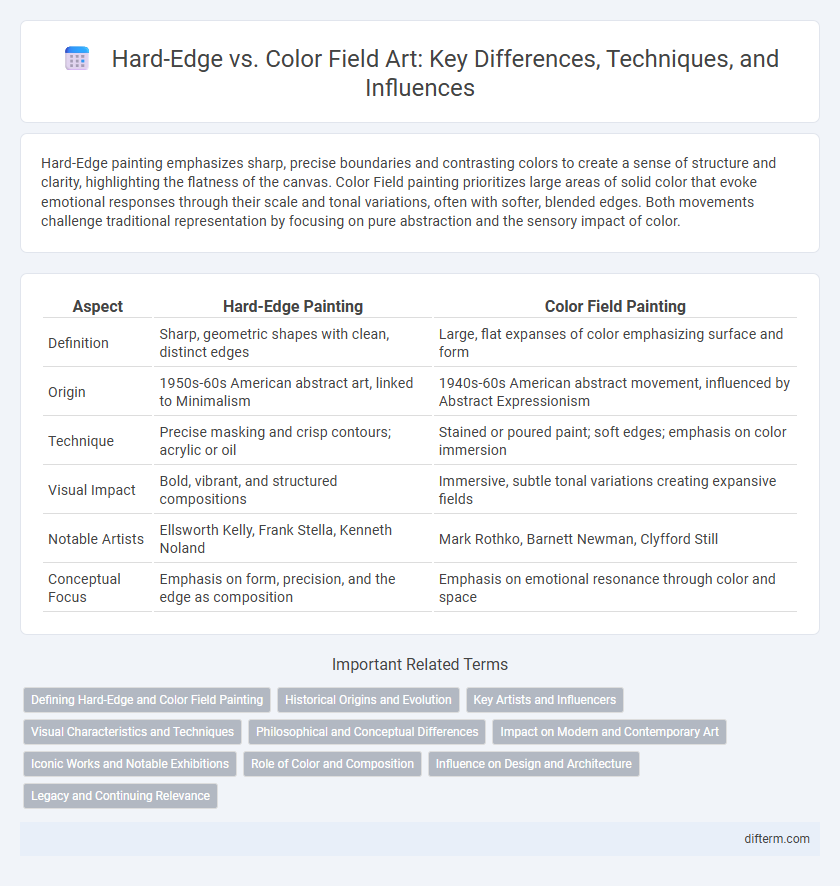Hard-Edge painting emphasizes sharp, precise boundaries and contrasting colors to create a sense of structure and clarity, highlighting the flatness of the canvas. Color Field painting prioritizes large areas of solid color that evoke emotional responses through their scale and tonal variations, often with softer, blended edges. Both movements challenge traditional representation by focusing on pure abstraction and the sensory impact of color.
Table of Comparison
| Aspect | Hard-Edge Painting | Color Field Painting |
|---|---|---|
| Definition | Sharp, geometric shapes with clean, distinct edges | Large, flat expanses of color emphasizing surface and form |
| Origin | 1950s-60s American abstract art, linked to Minimalism | 1940s-60s American abstract movement, influenced by Abstract Expressionism |
| Technique | Precise masking and crisp contours; acrylic or oil | Stained or poured paint; soft edges; emphasis on color immersion |
| Visual Impact | Bold, vibrant, and structured compositions | Immersive, subtle tonal variations creating expansive fields |
| Notable Artists | Ellsworth Kelly, Frank Stella, Kenneth Noland | Mark Rothko, Barnett Newman, Clyfford Still |
| Conceptual Focus | Emphasis on form, precision, and the edge as composition | Emphasis on emotional resonance through color and space |
Defining Hard-Edge and Color Field Painting
Hard-Edge painting is characterized by sharply defined geometric forms with clear, abrupt transitions between colors, emphasizing precision and clarity in composition. Color Field painting prioritizes large expanses of solid, flat color that create an immersive visual experience, often evoking emotional resonance through subtle tonal variations. Both movements emerged in the mid-20th century as responses to Abstract Expressionism, yet Hard-Edge focuses on crisp boundaries while Color Field emphasizes atmospheric depth and color harmony.
Historical Origins and Evolution
Hard-Edge painting emerged in the 1950s as a reaction to Abstract Expressionism, emphasizing sharp, geometric forms and uniform color areas with artists like Ellsworth Kelly and Frank Stella leading the movement. Color Field painting originated slightly earlier, in the late 1940s and early 1950s, with figures such as Mark Rothko and Barnett Newman using expansive fields of color to evoke emotional and spiritual responses. Both styles evolved concurrently, shaping mid-20th century modern art by exploring color's impact, yet Hard-Edge maintained a precise, crisp delineation while Color Field focused on immersive, atmospheric effects.
Key Artists and Influencers
Hard-Edge painting features sharp, geometric shapes and bold contrasts, with artists like Ellsworth Kelly and Frank Stella leading the movement. Color Field painting emphasizes expansive color areas and emotional resonance, prominently advanced by Mark Rothko and Barnett Newman. Both styles significantly influenced the evolution of Abstract Expressionism and Minimalism in mid-20th century art.
Visual Characteristics and Techniques
Hard-Edge painting emphasizes sharp, clean lines and distinct, flat areas of color, achieved through precise masking and controlled brushwork. Color Field art prioritizes large, sweeping expanses of subtle, luminous color created with staining or soaking techniques that produce soft edges and atmospheric depth. The visual contrast hinges on Hard-Edge's crisp geometric shapes versus the immersive, fluid color gradients central to Color Field works.
Philosophical and Conceptual Differences
Hard-Edge painting emphasizes precise geometric shapes and sharp contours to evoke clarity, objectivity, and rationality, reflecting a philosophy rooted in structure and formality. Color Field painting prioritizes expansive, luminous color areas that engage viewers emotionally and spiritually, embodying concepts of infinity, transcendence, and sensory immersion. These philosophical differences highlight Hard-Edge art's cognitive clarity contrasted with Color Field's focus on emotional resonance and meditative experience.
Impact on Modern and Contemporary Art
Hard-Edge painting, characterized by sharp transitions between color areas, revolutionized modern art by emphasizing geometric abstraction and clarity, influencing Minimalism and Graphic Design. Color Field painting, with its expansive washes of color and emotional depth, shaped contemporary art by exploring spatiality and the immersive power of color, impacting Abstract Expressionism and modern mural practices. Both movements challenged traditional representation and expanded the visual language of art, deeply affecting the development of 20th- and 21st-century aesthetics.
Iconic Works and Notable Exhibitions
Hard-Edge painting, characterized by sharply defined geometric forms and vibrant color contrasts, is exemplified by Ellsworth Kelly's "Spectrum Colors Arranged by Chance" and Frank Stella's "Die Fahne Hoch." Color Field painting emphasizes large expanses of uniform color to evoke emotional depth, with Mark Rothko's "No. 61 (Rust and Blue)" and Barnett Newman's "Vir Heroicus Sublimis" serving as iconic works. Notable exhibitions such as the 1959 "Four Abstract Classicists" showcased Hard-Edge painters, while the 1964 Whitney Museum exhibition "Post-Painterly Abstraction" featured prominent Color Field artists, highlighting the distinct approaches within mid-20th-century abstract art.
Role of Color and Composition
Hard-Edge painting emphasizes sharp, clear boundaries between flat areas of color, creating a structured and geometric composition that highlights contrast and precision. Color Field painting uses expansive, unmodulated areas of color to evoke emotional depth, prioritizing color as the primary vehicle for expression while often minimizing distinct shapes and lines. The role of color in Hard-Edge is to define form and space, whereas in Color Field it serves to immerse the viewer in a sensory experience through subtle gradations and vast chromatic fields.
Influence on Design and Architecture
Hard-Edge painting's precise lines and geometric forms influenced modern design and architecture by inspiring clean, minimalist aesthetics and structured spatial arrangements. Color Field painting, with its vast planes of bold, unmodulated color, impacted architectural use of expansive surfaces and immersive environments, emphasizing emotional engagement through color. Both movements contributed to the integration of art principles into architectural elements, promoting harmony between visual art and structural design.
Legacy and Continuing Relevance
Hard-Edge painting's legacy lies in its precise geometric abstraction, influencing minimalist and contemporary graphic design through its emphasis on clarity and form. Color Field painting's lasting impact is evident in its immersive, large-scale canvases that prioritize emotional resonance via expansive color usage, shaping modern visual experiences in both fine art and digital media. Both movements continue to inspire artists and designers by offering distinct approaches to color and composition, sustaining relevance in contemporary artistic practices.
Hard-Edge vs Color Field Infographic

 difterm.com
difterm.com